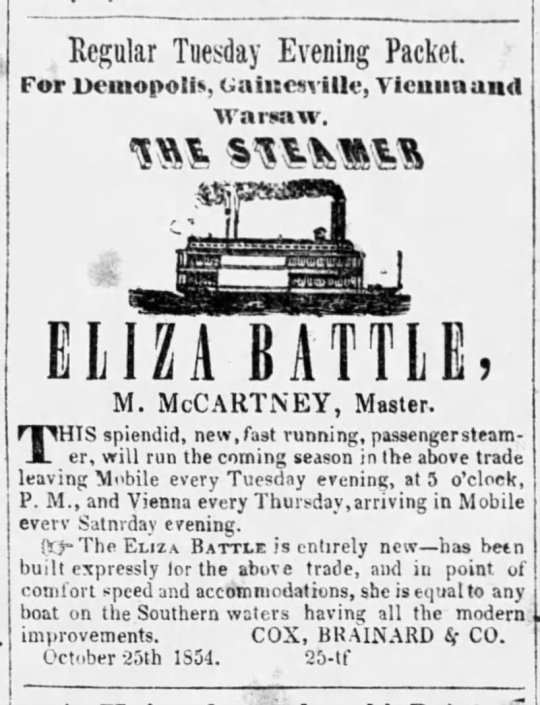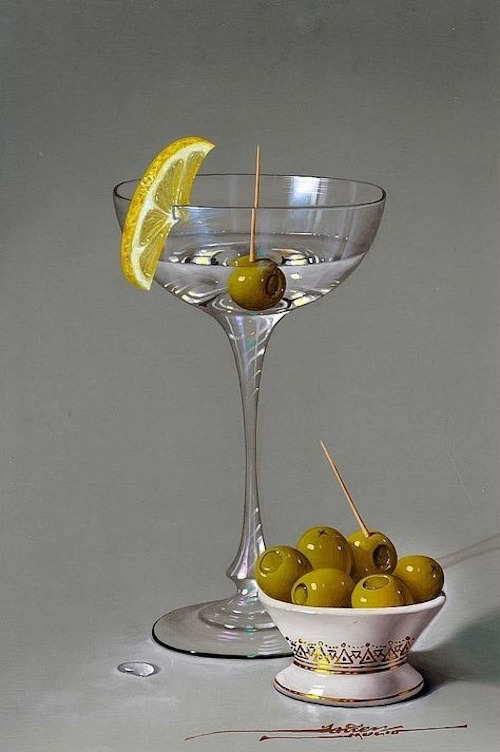#demopolis
Explore tagged Tumblr posts
Text
Amazing discovery in the attic of a Demopolis, Alabama home that once served as a hospital for Black people during Jim Crow. I believe we're just scratching the surface of untold Black History that can inspire the next generation.
blackhistory #geneaology
33 notes
·
View notes
Text
The Tombigbee River Phantom
The Eliza Battle was a sidewheel steamer, launched in New Albany, Indiana in 1852, which travelled regularly on the Tombigbee River between Columbus, Mississippi and Mobile, Alabama in the United States in the 1850s. She did the same in February 1858.

Advertising for the Eliza Battle
Captained by S. Graham Stone and piloted by Daniel Epps, the Eliza Battle left Columbus with a crew of 45. The ship was only able to travel so far north on the Tombigbee when the river was regularly flooded in the winter months, and made stops at Pickensville, Gainesville, Demopolis and numerous small piers on its way downstream. When the ship left Demopolis on 28 February 1858, it was fully loaded with 60 passengers and more than 1200 bales of cotton. A strong northerly wind set in during the already cold night, and the air temperature dropped into the minus range in the two hours after dark.
At about 2 a.m. on 1 March 1858, about 32 miles (51 km) downriver from Demopolis, near Beckley's Landing, the watch noticed that some of the cotton bales stored between the main deck had caught fire due to being too tight and were now burning. The fire, which was partly due to the strong wind, soon got out of control. The boat drifted further downstream and got out of control. Cut off from the lifeboat by the flames, the passengers, some of whom were clad only in their nightwear, were forced to go into the river to escape the flames. Some survived by floating on bales of cotton, hoping not to freeze in the sub-zero temperatures, but for many this was not the case. The Eliza Battle eventually came to rest above Kemp's Landing and sank to a depth of 8.5 metres. The few survivors were rescued by local residents, 33 or 45 of whom lost their lives in the freezing temperatures.

Eliza battle Tombigbee River 1858, by Ralph Richards
Now the Eliza Battle is no ordinary shipwreck, on the contrary she is said to surface regularly in February as a burning phantom trying to finish her route. But she often fails. She is also supposed to try to lure unsuspecting people who see her and want to help, because she is obviously in distress, and drag them down with her.
67 notes
·
View notes
Text
Glasses full

Janet Fish - Five Tall Glasses, Afternoon
::

Javier Mulio
::

Lucille Sevin
::

Shigeo Fukuda
::

Tina Engel 2023
::

René Lalique - 11-eyed blue-glass flacon
::

Janet Fish - Tequila Bottles, 1974
::

Hennie Elzinga
::

Andrew Moore - Bottles Corner, Demopolis, Alabama
::

Cy Twombly, 1951
::

Teddi Parker
::

Sir William Nicholson - The Glass Bowl, 1920
::

unknown illustration
::

Vincent van Grog
::

Dawn Reed - Five of my favourites
::

René Lalique
::

still life with Aaltos
::
Wednesday: swearing a blue streak
2 notes
·
View notes
Text
Truck Accident Lawyers in Demopolis - Your Best Chance for Fair Compensation
Over the years, truck accidents have become increasingly common, often resulting in devastating consequences for victims like you. Seeking the help of experienced truck accident lawyers in Demopolis is vital to navigating the complex legal landscape and ensuring that you receive fair compensation for your injuries and losses. Your unique situation demands a dedicated legal expert who understands…
0 notes
Text
Expertise in Demopolis Web Design
We are a team of professional and experienced web designers who know the ins and outs of Web Design Demopolis. Our years of experience and expertise in this domain have enabled us to design several successful and unique websites. So, you can be sure that we will be able to deliver a quality product that will grow your business online.
0 notes
Text
Sentiment degli Italiani: Cosa Significa per il Governo Meloni
Ottime notizie per Giorgia Meloni dal “barometro politico” di Demopolis, di cui rende conto il punto di Paolo Pagliaro a Otto e mezzo, su La7. Si sta del resto avverando quanto avevamo prefigurato ieri. La chiave del successo della premier in questa vicenda sembra essere stata la sua tempestività nel prendere in mano la narrazione. “Dando quel tono alla vicenda, si è intestata il dibattito”,…
0 notes
Text
Expertise in Demopolis Web Design
We are a team of professional and experienced web designers who know the ins and outs of Web Design Demopolis. Our years of experience and expertise in this domain have enabled us to design several successful and unique websites. So, you can be sure that we will be able to deliver a quality product that will grow your business online.
0 notes
Text

Washington St. in Demopolis, Alabama (year unknown).
0 notes
Text
SONDAGGIO: IL 73% DEGLI ITALIANI BOCCIA L’OPPOSIZIONE: PD PEGGIO DEL MOVIMENTO 5 STELLE.
Gli italiani promuovono Giorgia Meloni e bocciano Schlein e Conte.
Sondaggio Demopolis per Otto e Mezzo a La7. Gli italiani promuovono Giorgia Meloni e bocciano Schlein e Conte. Un anno di Governo: voti severi ma positivi per Giorgia Meloni anche se meno positivi per il Governo; giudizi impietosi nei confronti dell’intera opposizione. Siamo a La7 e ad annunciare questi numeri è proprio Lilli Gruber, mai troppo morbida con la Meloni e con il centrodestra.…

Visualizza su WordPress
0 notes
Text
Sondaggio politico: Fratelli d'Italia ancora primo partito, stacca di 9 punti il Pd
(Adnkronos) - Fratelli d’Italia con il 29% si conferma primo partito del Paese, staccando di 9 punti il Partito Democratico, attestato oggi al 20%. E' quanto emerge da Barometro Politico di ottobre dell'Istituto Demopolis. In terza posizione al 16,2% è il Movimento 5 Stelle. Al 9,8% troviamo la Lega, al 6,5% Forza Italia, al 3,7% Azione, al 3,4% Sinistra e Verdi, con tutte le altre liste sotto la soglia del 3%. Sondaggio politico, le parole di Pietro Vento “Nel confronto con le Politiche di poco più di anno fa – spiega il direttore di Demopolis, Pietro Vento – cresce di 3 punti il partito della Premier Meloni, di un punto o poco meno Pd, Movimento 5 stelle e la Lega di Salvini; perde oltre un punto e mezzo Forza Italia, orfana di Berlusconi”. Osservando i trend Demopolis, si nota che il consenso di Fratelli d’Italia resta da mesi stabile, poco sotto il 30%, prescindendo o quasi da eventi e fibrillazioni politiche. Il Pd di Elly Schlein, dopo aver recuperato a inizio 2022 con le Primarie i consensi perduti dopo le Politiche, resta da settimane secondo partito intorno al 20%, ma senza apparire per il momento in grado di mirare al primo gradino del podio elettorale. [email protected] (Web Info) Read the full article
0 notes
Text
It is regrettable that a significant number of individuals fail to acknowledge the pioneers who have laid the foundation for us to pursue and build upon.
0 notes
Text
WOZ.AI is a leading company that offers cutting-edge lead-generation solutions, with a focus on helping businesses efficiently and rapidly generate high-quality leads. Their state-of-the-art platform simplifies and automates the lead generation process, catering to businesses of all sizes. Through the utilization of this revolutionary solution, organizations can seamlessly connect with their target audience, encourage active involvement, and effectively transform leads into devoted customers.
0 notes

